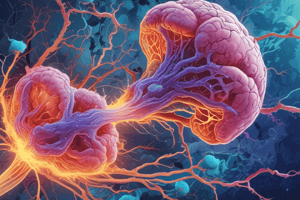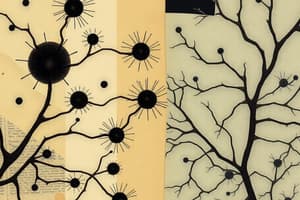Podcast
Questions and Answers
What is the primary function of astrocytes in the CNS?
What is the primary function of astrocytes in the CNS?
- To transmit signals between neurons
- To hold neurons together in proper spatial relationships (correct)
- To process and integrate sensory information
- To generate action potentials in neurons
What is the role of astrocytes during fetal brain development?
What is the role of astrocytes during fetal brain development?
- To regulate synaptic transmission
- To guide neurons to their proper final destination (correct)
- To form the blood-brain barrier
- To maintain the optimal ion conditions around neurons
What is the function of astrocytes in forming the blood-brain barrier?
What is the function of astrocytes in forming the blood-brain barrier?
- To regulate ion channels in the neurons
- To enhance synaptic plasticity
- To secrete neurotransmitters
- To induce the formation of capillaries (correct)
What do astrocytes take up from the brain extracellular fluid (ECF)?
What do astrocytes take up from the brain extracellular fluid (ECF)?
What is the role of astrocytes in neural scars?
What is the role of astrocytes in neural scars?
How do astrocytes regulate neurotransmitters?
How do astrocytes regulate neurotransmitters?
What is the role of glial cells in learning and memory?
What is the role of glial cells in learning and memory?
How do glial cells support neurons metabolically?
How do glial cells support neurons metabolically?
What is the main function of oligodendrocytes in the CNS?
What is the main function of oligodendrocytes in the CNS?
What is the function of microglia in the CNS?
What is the function of microglia in the CNS?
Study Notes
Microglia
- Microglia are the immune defense cells of the CNS and are similar to monocytes, a type of white blood cell.
- They are derived from the same bone-marrow tissue that gives rise to monocytes.
- In the resting state, microglia are wispy cells with many long branches that radiate outward.
- They release low levels of growth factors, such as nerve growth factor, which help neurons and other glial cells survive and thrive.
- Activated microglia release destructive chemicals to assault against their target, which can damage neurons they are meant to protect, contributing to neurodegenerative diseases.
- Microglia are the only CNS cell type that can be infected by HIV, leading to AIDS-related dementia.
Ependymal Cells
- Ependymal cells line the internal, fluid-filled cavities of the CNS and help form cerebrospinal fluid.
- They have cilia that beat to contribute to the flow of cerebrospinal fluid through the ventricles.
- Ependymal cells serve as neural stem cells with the potential to form new neurons, especially after injury.
- They can form other glial cells, and unlike neurons, they do not lose the ability to undergo cell division.
Protection and Nourishment of the Brain
- The brain is not supplied by the lymphatic system, but instead uses the glymphatic system for waste clearance.
- Astrocytes facilitate a cleansing fluid exchange within spaces between microscopic brain blood vessels and long astrocyte projections.
- This "brainwashing" increases during sleep.
Oligodendrocytes
- Oligodendrocytes form the insulative myelin sheaths around axons in the CNS.
- Each oligodendrocyte has several elongated projections that wrap around a section of an interneuronal axon to form a patch of myelin.
Glial Cells
- Glial cells help support neurons both physically and metabolically.
- They maintain the composition of the specialized extracellular environment surrounding neurons within optimal limits.
- They actively modulate synaptic function and are considered crucial to learning and memory.
- There are four major types of glial cells in the CNS: astrocytes, oligodendrocytes, microglia, and ependymal cells.
Astrocytes
- Astrocytes are the most abundant glial cells and fill several critical functions.
- They hold neurons together in proper spatial relationships, serving as the "glue" of the CNS.
- They guide neurons to their proper final destination during fetal brain development.
- They induce the formation of the blood-brain barrier, a highly selective and protective barricade between the blood and brain.
- They help transfer nutrients from the blood to the neurons and form neural scars to repair brain injuries.
Studying That Suits You
Use AI to generate personalized quizzes and flashcards to suit your learning preferences.
Description
This quiz covers the role of microglia in the central nervous system, their response to infection, and their contribution to neurodegenerative diseases such as Alzheimer's and multiple sclerosis.




